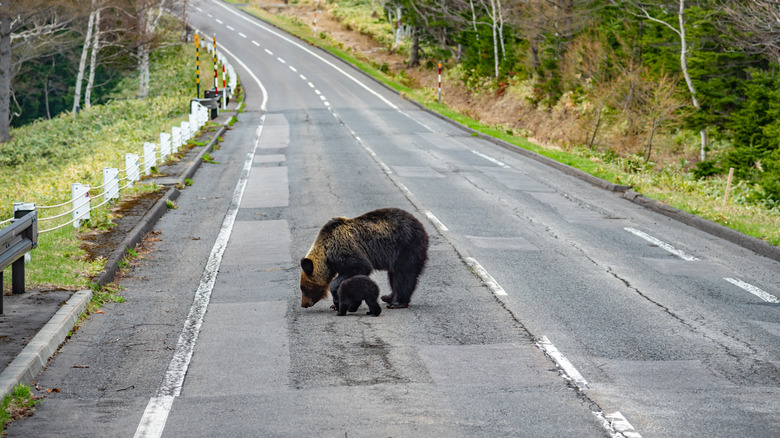Some Of The World's Best Nature Trails Are On A Japanese Island Full Of Unique Landscapes
Japan's northernmost island of Hokkaido is one of its most rugged and least developed sites, making it a true hiker's paradise. Hokkaido is renowned for its volcanic landscape, natural hot springs, and alpine lakes, and there are trails all over Hokkaido, leading to some of Japan's most well-known mountain peaks. You might even catch a glimpse of some brown bears, which are all around the island. With blue ponds, mossy gorges, and volcanic lakes, it's no surprise that in 2003, the Hokkaido Nature Trail was announced, a proposed over 2,800-mile trek made up of trails around the island. While this major project hasn't yet been completed, there are plenty of half-, full-, and multi-day hikes all over Hokkaido that will bring you face-to-face with unique landscapes and awe-inspiring views.
Although Hokkaido offers a remote, off-the-grid getaway, luckily, it's not too difficult to reach. The easiest and most convenient way is to take a 1.5-hour flight from Tokyo to the island's New Chitose Airport, which is about a 50-minute drive to Sapporo, the capital of Hokkaido, which is surprisingly similar to Switzerland's Zermatt without the crowds. While there's public transportation on Hokkaido, and it's possible to build a budget-focused itinerary using trains and buses, if your main focus is hiking, the best way to access all of the island's spectacular nature is to rent a car.
Hokkaido's volcanos, lakes, and peridotite (oh my!)
The dramatic Daisetsuzan National Park is Japan's "playground of the gods" and Hokkaido's most popular park for hikers since it's home to three of Japan's famed 100 mountains, first catalogued in a popular 1964 book published by mountaineer Kyuya Fukada. Here, you'll find Tomuraushi, Tokachidake, and the island's tallest peak, Asahidake, which has several paths, ranging from half- to multi-day journeys. The Daisetsuzan Grand Traverse is a six- to eight-day hike that crosses the park from Mount Asahidake or Mount Kurodake in the north to Mount Furanodake in the south, covering up to 50 miles, depending on the route. About a 2.5-hour drive from Sapporo, Daisetsuzan National Park offers a clear picture of all that Hokkaido has to offer, with volcanic peaks, smoking fissures, hot springs, colorful wildflowers, and alpine lakes.
From Daisetsuzan, it's about a four-hour drive to the epic landscapes in Shiretoko National Park. Active volcanoes form the rugged backdrop to this park, which features five lakes formed by the eruption of Mount Io. There's an easy 2-mile loop around the lakes, part of which is a boardwalk that's accessible for wheelchairs and strollers, making this a perfect place to visit with the family.
Geology lovers and those looking for a unique landscape (even among Hokkaido's diverse offerings) can venture six hours south along the coast to check out Mount Apoi, a UNESCO-designated Geopark, which captures elements of the island's formation. Hokkaido was once two separate pieces of land on continental plates that merged over time, and Mount Apoi showcases that million-year-old history with its greenish peridotite peak created from the earth's mantle. There's a 2.5-mile out-and-back trail to the top, although you'll find a variety of hiking paths around this geopark, whose mountain offers clear views of the Pacific Ocean.
Tips to hike safely in Hokkaido
Hokkaido is wild in the truest sense of the word: the weather can be fickle, and animals — notably, brown bears — are everywhere. Many recommend hiking with bear spray and bells during the daytime, since bears are active in the mornings and evenings. Practice leave no trace, particularly with food and trash, to avoid any cute but unwelcome visitors. There are various resources online that update locations of brown bear sightings, such as the City of Sapporo website, and you can check with park rangers or visitor centers as well for updates to ensure that you have the proper safety information you need to know before hiking alone. Other local resources like Hokkaido Wilds and Hike Master Japan offer exhaustive information on safety measures, as well as comprehensive lists of the trails in Hokkaido, which are essential for anyone planning a trip to the island.
It's best to schedule one to two extra days in your itinerary to account for potentially bad weather. This island is the last to get the cherry blossom bloom in the springtime — usually in early May — but trails and roads still might be blocked by snow at that time. Autumn also provides a fantastic colorful landscape of changing leaves and foliage, but is also more prone to seeing rain, while winter is the hardest time to hike around Hokkaido, as this mountainous island tends to receive a high amount of snow. That means summer is the safest time to hike, particularly if you want to make sure you can get to the top of one or more of Hokkaido's many, many mountains.


